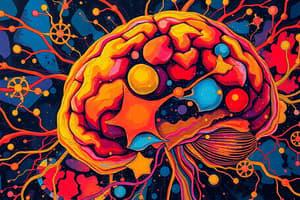Podcast
Questions and Answers
What are the three main functions of the nervous system?
What are the three main functions of the nervous system?
- Sensory input, integration, motor output (correct)
- Sensory, motor, cognitive
- Input, processing, output
- Thinking, feeling, reacting
Which part of the nervous system regulates involuntary functions like heartbeat and digestion?
Which part of the nervous system regulates involuntary functions like heartbeat and digestion?
- Motor division
- Central nervous system
- Somatic nervous system
- Autonomic nervous system (correct)
What type of cells outnumber neurons in the nervous system and play a supportive role?
What type of cells outnumber neurons in the nervous system and play a supportive role?
- Motor cells
- Glial cells (correct)
- Sensory cells
- Interneurons
Which part of the body do sensory neurons activate when a spider crawls on the skin?
Which part of the body do sensory neurons activate when a spider crawls on the skin?
What are interneurons primarily responsible for in the nervous system?
What are interneurons primarily responsible for in the nervous system?
Flashcards are hidden until you start studying
Study Notes
- Daily activities like feeling cold, making toast, and responding to a whining dog are all controlled by the nervous system through electrical and chemical signals.
- The nervous system is crucial for controlling all organs, physiological and psychological reactions, and interactions with the endocrine system.
- The nervous system encompasses three main functions - sensory input, integration, and motor output, which govern actions, thoughts, and emotions.
- It consists of the central nervous system (brain and spinal cord) and the peripheral nervous system (nerves branching off from the brain and spine).
- The peripheral nervous system has sensory (afferent) and motor (efferent) divisions, including the somatic and autonomic nervous systems that regulate voluntary and involuntary functions.
- Glial cells, outnumbering neurons by about 10 to 1, play a crucial role in supporting and protecting neurons in the nervous system.
- Neurons, specialized cells with a long lifespan, unique structure, and high metabolic rate, serve as the primary communicators in the nervous system, transmitting signals throughout the body.- Interneurons, also known as association neurons, are abundant in the central nervous system and facilitate communication between sensory and motor neurons.
- When a spider crawls on your skin, the sensory neurons in the skin are activated, sending a signal through the spinal cord to multipolar interneurons.
- These interneurons can trigger different responses: some signal to muscles like the quadriceps to kick your leg, while others transmit the signal to the brain for interpretation of the sensation.
- The communication between neurons is essential for reactions like screaming and flailing or calmly removing the spider, showcasing the role of neuron connections in decision-making.
- The complexity of nerve cell communication through a combination of chemistry and electricity is a fundamental aspect of the nervous system, which will be covered in the next lesson.
Studying That Suits You
Use AI to generate personalized quizzes and flashcards to suit your learning preferences.





